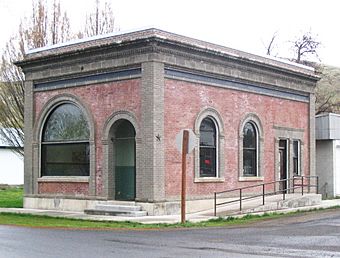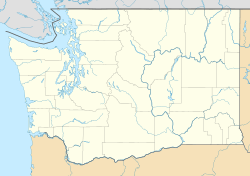Bank of Starbuck facts for kids
Quick facts for kids |
|
|
Bank of Starbuck
|
|
 |
|
| Location | Main and McNeil Sts., Starbuck, Washington |
|---|---|
| Area | less than one acre |
| Built | 1904 |
| NRHP reference No. | 78002739 |
| Added to NRHP | February 8, 1978 |
The Bank of Starbuck is a very old and important building. It is located in Starbuck, Washington, at the corner of Main and McNeil Streets. This historic building was built in 1904. It was officially added to the National Register of Historic Places in 1978. This means it is a special place worth protecting.
Contents
The Historic Bank of Starbuck
The Bank of Starbuck is more than just an old building. It tells a story about the town's past. When it was built, Starbuck was a busy and growing place. The bank helped the town's businesses and people. It was a central part of daily life.
What Makes This Bank Special?
This bank building is important for a few reasons. It is one of the few old business buildings left from Starbuck's busiest time. This period was after a major railway line, built by the Oregon Railroad and Navigation Company, arrived in 1882. The railway helped the town grow a lot.
Experts also say it is a great example of a small town bank from the western United States. It shows how banks looked and worked back then. Its design and history make it unique.
A Look Back at Starbuck's History
Starbuck, Washington, became a busy town because of the railroad. The railway made it easier to move goods and people. This brought new businesses and families to the area. The Bank of Starbuck was built during this exciting time. It helped the town's economy grow.
The bank served the community for many years. It was where people saved money and businesses got loans. It played a big part in the town's development.
Why Are Buildings Listed as Historic?
Buildings like the Bank of Starbuck are listed on the National Register of Historic Places because they are important. They help us understand history. They show us how people lived and worked in the past. Protecting these buildings means we can learn from them for many years to come. It helps keep our history alive.


